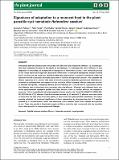Files in this item
Signatures of adaptation to a monocot host in the plant-parasitic cyst nematode Heterodera sacchari
Item metadata
| dc.contributor.author | Pokhare, Somnath S. | |
| dc.contributor.author | Thorpe, Peter | |
| dc.contributor.author | Hedley, Pete | |
| dc.contributor.author | Morris, Jennifer | |
| dc.contributor.author | Habash, Samer S. | |
| dc.contributor.author | Elashry, Abdelnaser | |
| dc.contributor.author | Eves-van den Akker, Sebastian | |
| dc.contributor.author | Grundler, Florian M. W. | |
| dc.contributor.author | Jones, John | |
| dc.date.accessioned | 2020-07-22T16:30:04Z | |
| dc.date.available | 2020-07-22T16:30:04Z | |
| dc.date.issued | 2020-08-17 | |
| dc.identifier | 268711334 | |
| dc.identifier | 3d49e0fc-02a4-4307-bbc7-a15e1527312b | |
| dc.identifier | 85088307639 | |
| dc.identifier | 000550895100001 | |
| dc.identifier.citation | Pokhare , S S , Thorpe , P , Hedley , P , Morris , J , Habash , S S , Elashry , A , Eves-van den Akker , S , Grundler , F M W & Jones , J 2020 , ' Signatures of adaptation to a monocot host in the plant-parasitic cyst nematode Heterodera sacchari ' , The Plant Journal , vol. 103 , no. 4 , pp. 1263-1274 . https://doi.org/10.1111/tpj.14910 | en |
| dc.identifier.issn | 0960-7412 | |
| dc.identifier.uri | https://hdl.handle.net/10023/20310 | |
| dc.description | Somnath Pokhare was supported by a fellowship provided by the Indian Council of Agricultural Research (ICAR), Government of India. This work was also supported by Royal Society International Exchanges award number IE150670 and by the Rural and Environmental Science and Analytical Services Division of the Scottish Government. SEvdA is supported by Biotechnology and Biological Sciences Research Council grants BB/R011311/1 and BB/S006397/1. This work benefited from interactions funded through COST Action FA1208. The authors thank Dr Danny Coyne (IITA) for providing the starter culture of the H. sacchari population used for this work. Bioinformatics and Computational Biology analyses were supported by the University of St Andrews Bioinformatics Unit which is funded by a Wellcome Trust ISSF award [grant 105621/Z/14/Z]. | en |
| dc.description.abstract | Interactions between plant‐parasitic nematodes and their hosts are mediated by effectors, i.e. secreted proteins that manipulate the plant to the benefit of the pathogen. To understand the role of effectors in host adaptation in nematodes, we analysed the transcriptome of Heterodera sacchari , a cyst nematode parasite of rice (Oryza sativa ) and sugarcane (Saccharum officinarum ). A multi‐gene phylogenetic analysis showed that H. sacchari and the cereal cyst nematode Heterodera avenae share a common evolutionary origin and that they evolved to parasitise monocot plants from a common dicot‐parasitic ancestor. We compared the effector repertoires of H. sacchari with those of the dicot parasites Heterodera glycines and Globodera rostochiensis to understand the consequences of this transition. While, in general, effector repertoires are similar between the species, comparing effectors and non‐effectors of H. sacchari and G. rostochiensis shows that effectors have accumulated more mutations than non‐effectors. Although most effectors show conserved spatiotemporal expression profiles and likely function, some H. sacchari effectors are adapted to monocots. This is exemplified by the plant‐peptide hormone mimics, the CLAVATA3/EMBRYO SURROUNDING REGION‐like (CLE) effectors. Peptide hormones encoded by H. sacchari CLE effectors are more similar to those from rice than those from other plants, or those from other plant‐parasitic nematodes. We experimentally validated the functional significance of these observations by demonstrating that CLE peptides encoded by H. sacchari induce a short root phenotype in rice, whereas those from a related dicot parasite do not. These data provide a functional example of effector evolution that co‐occurred with the transition from a dicot‐parasitic to a monocot‐parasitic lifestyle. | |
| dc.format.extent | 12 | |
| dc.format.extent | 2663435 | |
| dc.language.iso | eng | |
| dc.relation.ispartof | The Plant Journal | en |
| dc.subject | Peptide hormone mimics | en |
| dc.subject | Effectors | en |
| dc.subject | Heterodera sacchari | en |
| dc.subject | Transcriptomics | en |
| dc.subject | QH301 Biology | en |
| dc.subject | DAS | en |
| dc.subject.lcc | QH301 | en |
| dc.title | Signatures of adaptation to a monocot host in the plant-parasitic cyst nematode Heterodera sacchari | en |
| dc.type | Journal article | en |
| dc.contributor.sponsor | The Wellcome Trust | en |
| dc.contributor.institution | University of St Andrews. School of Medicine | en |
| dc.contributor.institution | University of St Andrews. Biomedical Sciences Research Complex | en |
| dc.contributor.institution | University of St Andrews. School of Biology | en |
| dc.identifier.doi | https://doi.org/10.1111/tpj.14910 | |
| dc.description.status | Peer reviewed | en |
| dc.date.embargoedUntil | 2020-07-22 | |
| dc.identifier.grantnumber | 105621/Z/14/Z | en |
This item appears in the following Collection(s)
Items in the St Andrews Research Repository are protected by copyright, with all rights reserved, unless otherwise indicated.

